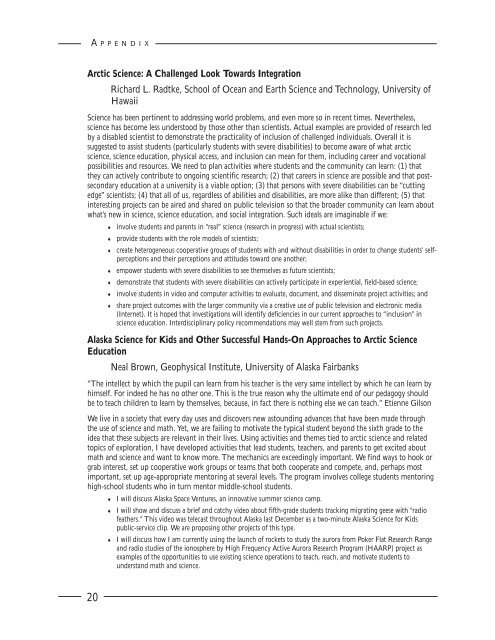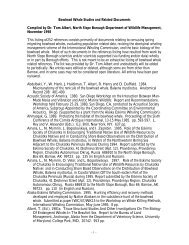ed report 4 page cover - Arctic Research Consortium of the United ...
ed report 4 page cover - Arctic Research Consortium of the United ...
ed report 4 page cover - Arctic Research Consortium of the United ...
You also want an ePaper? Increase the reach of your titles
YUMPU automatically turns print PDFs into web optimized ePapers that Google loves.
A P P E N D I X<br />
<strong>Arctic</strong> Science: A Challeng<strong>ed</strong> Look Towards Integration<br />
Richard L. Radtke, School <strong>of</strong> Ocean and Earth Science and Technology, University <strong>of</strong><br />
Hawaii<br />
Science has been pertinent to addressing world problems, and even more so in recent times. Never<strong>the</strong>less,<br />
science has become less understood by those o<strong>the</strong>r than scientists. Actual examples are provid<strong>ed</strong> <strong>of</strong> research l<strong>ed</strong><br />
by a disabl<strong>ed</strong> scientist to demonstrate <strong>the</strong> practicality <strong>of</strong> inclusion <strong>of</strong> challeng<strong>ed</strong> individuals. Overall it is<br />
suggest<strong>ed</strong> to assist students (particularly students with severe disabilities) to become aware <strong>of</strong> what arctic<br />
science, science <strong>ed</strong>ucation, physical access, and inclusion can mean for <strong>the</strong>m, including career and vocational<br />
possibilities and resources. We ne<strong>ed</strong> to plan activities where students and <strong>the</strong> community can learn: (1) that<br />
<strong>the</strong>y can actively contribute to ongoing scientific research; (2) that careers in science are possible and that postsecondary<br />
<strong>ed</strong>ucation at a university is a viable option; (3) that persons with severe disabilities can be “cutting<br />
<strong>ed</strong>ge” scientists; (4) that all <strong>of</strong> us, regardless <strong>of</strong> abilities and disabilities, are more alike than different; (5) that<br />
interesting projects can be air<strong>ed</strong> and shar<strong>ed</strong> on public television so that <strong>the</strong> broader community can learn about<br />
what’s new in science, science <strong>ed</strong>ucation, and social integration. Such ideals are imaginable if we:<br />
♦ involve students and parents in “real” science (research in progress) with actual scientists;<br />
♦ provide students with <strong>the</strong> role models <strong>of</strong> scientists;<br />
♦ create heterogeneous cooperative groups <strong>of</strong> students with and without disabilities in order to change students’ selfperceptions<br />
and <strong>the</strong>ir perceptions and attitudes toward one ano<strong>the</strong>r;<br />
♦ empower students with severe disabilities to see <strong>the</strong>mselves as future scientists;<br />
♦ demonstrate that students with severe disabilities can actively participate in experiential, field-bas<strong>ed</strong> science;<br />
♦ involve students in video and computer activities to evaluate, document, and disseminate project activities; and<br />
♦ share project outcomes with <strong>the</strong> larger community via a creative use <strong>of</strong> public television and electronic m<strong>ed</strong>ia<br />
(Internet). It is hop<strong>ed</strong> that investigations will identify deficiencies in our current approaches to “inclusion” in<br />
science <strong>ed</strong>ucation. Interdisciplinary policy recommendations may well stem from such projects.<br />
Alaska Science for Kids and O<strong>the</strong>r Successful Hands-On Approaches to <strong>Arctic</strong> Science<br />
Education<br />
Neal Brown, Geophysical Institute, University <strong>of</strong> Alaska Fairbanks<br />
“The intellect by which <strong>the</strong> pupil can learn from his teacher is <strong>the</strong> very same intellect by which he can learn by<br />
himself. For inde<strong>ed</strong> he has no o<strong>the</strong>r one. This is <strong>the</strong> true reason why <strong>the</strong> ultimate end <strong>of</strong> our p<strong>ed</strong>agogy should<br />
be to teach children to learn by <strong>the</strong>mselves, because, in fact <strong>the</strong>re is nothing else we can teach.” Etienne Gilson<br />
We live in a society that every day uses and dis<strong>cover</strong>s new astounding advances that have been made through<br />
<strong>the</strong> use <strong>of</strong> science and math. Yet, we are failing to motivate <strong>the</strong> typical student beyond <strong>the</strong> sixth grade to <strong>the</strong><br />
idea that <strong>the</strong>se subjects are relevant in <strong>the</strong>ir lives. Using activities and <strong>the</strong>mes ti<strong>ed</strong> to arctic science and relat<strong>ed</strong><br />
topics <strong>of</strong> exploration, I have develop<strong>ed</strong> activities that lead students, teachers, and parents to get excit<strong>ed</strong> about<br />
math and science and want to know more. The mechanics are exce<strong>ed</strong>ingly important. We find ways to hook or<br />
grab interest, set up cooperative work groups or teams that both cooperate and compete, and, perhaps most<br />
important, set up age-appropriate mentoring at several levels. The program involves college students mentoring<br />
high-school students who in turn mentor middle-school students.<br />
♦ I will discuss Alaska Space Ventures, an innovative summer science camp.<br />
♦ I will show and discuss a brief and catchy video about fifth-grade students tracking migrating geese with “radio<br />
fea<strong>the</strong>rs.” This video was telecast throughout Alaska last December as a two-minute Alaska Science for Kids<br />
public-service clip. We are proposing o<strong>the</strong>r projects <strong>of</strong> this type.<br />
♦ I will discuss how I am currently using <strong>the</strong> launch <strong>of</strong> rockets to study <strong>the</strong> aurora from Poker Flat <strong>Research</strong> Range<br />
and radio studies <strong>of</strong> <strong>the</strong> ionosphere by High Frequency Active Aurora <strong>Research</strong> Program (HAARP) project as<br />
examples <strong>of</strong> <strong>the</strong> opportunities to use existing science operations to teach, reach, and motivate students to<br />
understand math and science.<br />
20




